How Long Does It Take to Build a Pool?
Building a pool is an exciting project that can completely transform the look and value of a backyard. From planning and design to construction and finishing touches, there are several steps involved, and each one takes time to complete.
For many homeowners, this is a significant investment, as pools can also add significant value to a home. In fact, recent reports show that homes with a pool
have a median listing price of $599,000, compared to $389,000 for homes without an in-ground swimming area. With so much in line, it’s crucial for homeowners to assess the total timeline and prevent costly delays in the process.
Here is a typical overview of how long does it take to build a pool from start to finish and what to expect at each stage.
Table of Contents
- Key Takeaways
- How Long Does It Take to Build a Pool?
- Phase 1: Design (1 to 4 Weeks)
- Phase 2: Permitting (2 to 6 Weeks)
- Phase 3: Excavation (1 Week)
- Phase 4: Steel, Plumbing, and Electrical Work (1 to 2 Weeks)
- Phase 5: Pool Shell Application (1 to 3 Weeks)
- Phase 6: Decking, Landscaping, and Custom Features (1 to 4 Weeks)
- Total Timeline: 8 to 12 Weeks on Average
- Frequently Asked Questions
- Build A Custom Pool Project With Experts In Danbury, CT!
Key Takeaways
✔ The design phase sets the foundation for the project and typically takes 1 to 4 weeks to finalize plans and details.
✔ Permitting can take 2 to 6 weeks, depending on local regulations and approval timelines.
✔ Excavation usually takes about a week, though weather and site conditions can cause delays.
✔ Steel installation, plumbing, and electrical work generally take 1 to 2 weeks to complete.
✔ The pool shell application, whether gunite, plaster, vinyl, or fiberglass, takes 1 to 3 weeks and may require curing time.
✔ Decking, landscaping, and custom features take 1 to 4 weeks to finish and bring the entire project together.
✔ The total time to build a pool is typically 8 to 12 weeks, though factors like weather, permits, and complexity can extend the timeline.

How Long Does It Take to Build a Pool?
Phase 1: Design (1 to 4 Weeks)
The design phase is the first and one of the most important steps in the pool building process timeline. During this stage, homeowners work with professionals to create a custom layout that fits their yard, lifestyle, and budget. A well-thought-out design can help avoid delays later on and ensures that all features are included from the start.
Planning the Layout
Before construction begins, a clear layout of the pool needs to be developed. This involves visualizing how the pool will fit in the backyard and what kind of experience it will offer.
- Backyard Shape and Space: Determines where the pool will go and how large it can be. Uneven or tight spaces may require custom solutions.
- Pool Type and Style: Choices include rectangular, freeform, geometric, or custom shapes depending on aesthetic goals and functionality.
- Entry and Exit Points: Placement of steps, ladders, or beach entries is planned for easy access.
- Safety Zones: Locations for fences, gates, and non-slip surfaces are identified to meet safety standards.
Choosing Features and Materials
The materials and add-ons selected during this phase directly impact the pool's look, feel, and long-term maintenance.
- Pool Finish Materials: Options include plaster, pebble, tile, or vinyl. Each has a different texture, appearance, and maintenance level.
- Decking Options: Concrete, pavers, or stone can be chosen based on durability and style preference.
- Built-In Features: Includes spas, waterfalls, benches, tanning shelves, and lighting for added comfort and beauty.
- Water Systems: Filtration, heating, and cleaning systems are discussed to match usage needs and energy efficiency goals.
Collaborating With Pool Designers or Contractors
Professional guidance is key in turning ideas into a workable plan. A contractor or pool designer helps make informed decisions and provides insight on local regulations.
- Site Visit and Measurements: The team surveys the yard to measure the space and identify challenges.
- Preliminary Sketches and Revisions: Several drafts are created and adjusted to finalize the best layout.
- Budget and Cost Planning: Helps determine what is possible within the homeowner’s price range while aligning with project goals.
- Permit Readiness: Design plans are created to meet local codes so they’re ready for the permitting phase.
Phase 2: Permitting (2 to 6 Weeks)
Getting the right permits is a big step in the pool building process timeline. Every area has its own rules and regulations, so it is important to know what is required before construction begins. This step can affect how long does it take to build a pool from start to finish.
What Permits Are Needed
There are different types of permits needed depending on where the pool will be built and its design:
- Building Permit: This allows the construction of the pool structure itself and makes sure it meets safety codes. It ensures that the pool design is safe and follows all local building regulations.
- Electrical Permit: This covers wiring for lights, pumps, and other electrical components. It also helps prevent future hazards by making sure all electrical work meets safety standards.
- Plumbing Permit: This ensures that all pipes and drainage systems are installed correctly. A proper plumbing permit helps avoid leaks or water contamination issues.
- Zoning Approval: This confirms that the pool follows local property setback rules and other zoning laws. Without this approval, the pool might be too close to property lines or other restricted areas.
What Can Affect Permit Processing Time
There are several factors that can affect how long does it take to build a pool in your backyard, especially when it comes to permits:
- Location: Different cities and counties have their own timelines for permit reviews. Some areas have faster processes, while others may take longer due to stricter regulations.
- Project Complexity: Custom designs or features like spas and waterfalls may need extra reviews. More complex projects require detailed plans that can take additional time to approve.
- Season: Permit offices can get busy during peak building seasons, which may cause delays. Applying during slower months can sometimes shorten wait times.
Phase 3: Excavation (1 Week)
Excavation is when the ground is dug up to create the shape and depth of the pool. This step usually moves quickly, but it is an important part of the pool building process timeline.
What Happens During Excavation
The
excavation process sets the foundation for the pool:
- Marking the Area: The pool’s outline is marked on the ground based on the approved design. Clear markings help the crew dig in the correct location and at the correct dimensions.
- Digging: Heavy equipment is used to dig the soil and form the pool’s shape and depth. Skilled operators carefully follow the design to ensure proper contours and levels.
- Soil Removal: The removed soil is either hauled away or used elsewhere on the property. This helps keep the worksite clean and allows construction to move forward without obstacles.
What Can Delay Excavation
Even though excavation can be done in about a week, some factors can cause delays:
- Weather Conditions: Rain or flooding can make the soil unstable and unsafe for digging. Wet conditions can also cause machinery to get stuck or damage the property.
- Unexpected Obstacles: Large rocks, tree roots, or utility lines can slow down the work. Crews often need extra time and equipment to safely handle these challenges.
- Equipment Access: Limited space in a backyard can make it harder to bring in excavation equipment. Narrow entrances or obstacles may require special tools or manual labor, extending the timeline.

Phase 4: Steel, Plumbing, and Electrical Work (1 to 2 Weeks)
This phase of the pool building process timeline focuses on building the core structure and installing essential systems. It usually takes about one to two weeks and is a critical step in how long does it take to build a pool in your backyard because it ensures the pool is safe and functional for the long term.
Structural Steel Framework
The steel framework acts as the pool's skeleton, providing strength and durability. This step is especially important for concrete pools, as it determines how well the pool can handle the pressure of the surrounding soil and water.
- Reinforcing the Pool Structure: Steel bars, also called rebar, are placed throughout the excavated hole to create a sturdy skeleton for the pool. The steel grid helps the pool walls and floor withstand pressure from the surrounding soil and water, making the entire structure stronger.
- Bonding the Steel to the Pool Shell: The rebar is securely tied together at key points to ensure that the steel framework is stable and resistant to movement. This process ensures that the steel and the pool shell work together as a cohesive unit.
Plumbing Installation
Plumbing installation ensures water can flow freely and remain clean inside the pool. This includes a network of pipes that manage circulation and connect to all the essential equipment.
- Setting Up Water Circulation: Plumbing lines are installed to manage the constant flow of water in and out of the pool. These lines connect skimmers, drains, and return jets, ensuring water moves efficiently and stays clean.
- Filtration and Equipment Lines: Additional plumbing is added for filters, heaters, and optional water features like waterfalls or fountains. Correct placement of these lines helps avoid future maintenance problems and ensures every system works properly.
Electrical Setup
The electrical setup powers all the key systems that keep the pool running smoothly. It also adds safety and convenience with properly installed lighting and equipment.
- Wiring for Lighting and Equipment: Electricians run wires for pumps, lights, heaters, and other powered equipment. Careful installation at this stage guarantees the systems are safe to use and reliable over time.
- Configuring Pool Control Systems: During the electrical setup, technicians install and configure control systems that allow pool owners to operate pumps, heaters, and lights from a central location. These systems can include timers, remote controls, and automation setups that improve the pool's efficiency and ease of use.
Phase 5: Pool Shell Application (1 to 3 Weeks)
In this phase, the pool begins to take its finished form as the chosen shell material is applied or installed. The time needed can vary, especially for those asking how long does it take to build a concrete pool, because curing may take longer compared to other materials.
Pool Material Options
The choice of pool material will determine how the shell is applied and how long this phase will take. Each option has different installation methods and timelines.
- Gunite or Shotcrete: A layer of concrete is sprayed over the steel framework and shaped to create the pool’s interior. This method is highly durable but usually requires more time due to its curing process.
- Plaster: A smooth plaster finish is applied to create a watertight interior surface. The result is a polished look that also protects the underlying structure from damage.
- Vinyl Liner: A custom-fit liner is installed and secured along the pool walls and floor. The liner must be stretched and fitted carefully to avoid wrinkles or leaks.
- Fiberglass Shell: A prefabricated fiberglass shell is delivered and carefully lowered into place. This option is quicker because most of the construction is completed offsite.
Curing or Installation Time
Curing and installation time depend on the type of pool material used. Concrete pools must cure for up to two weeks to fully harden, which strengthens the structure. Fiberglass and vinyl pools do not require curing, so they typically move to the next phase much faster.
Phase 6: Decking, Landscaping, and Custom Features (1 to 4 Weeks)
The last major step in the pool building process timeline is adding the finishing touches. These additional options may vary depending on the builder, so it is always best to ask reputable builders like FJV Construction for specific details on what they offer and timelines.
Deck or Patio Installation
A
deck or patio is built around the pool to create a comfortable space for relaxing and entertaining. The type of material chosen can affect both the appearance and how long does it take to build a pool in your backyard during this phase.
- Concrete Decking: Concrete decking is durable and versatile, offering options like stamped or textured finishes for a custom look. These finishes not only add style but also provide slip resistance for added safety.
- Pavers: Pavers are attractive and come in a variety of colors and shapes, making it easy to match the pool design. They are also easy to replace individually if one gets damaged, which can help maintain the pool area long-term.
- Wood or Composite Decking: Wood or composite decking gives a warm, natural feel that many homeowners love. It may require more maintenance than other materials, but it can significantly enhance the overall aesthetic of the backyard.
Adding Optional Features
Optional features are added during this stage, which can make the pool area more functional or visually appealing. The number and type of features selected can also impact how long does it take to build a concrete pool.
- Waterfalls or Fountains: Waterfalls or fountains add a dynamic element that enhances the relaxing atmosphere of the pool. They also improve water circulation, which can help keep the pool cleaner.
- Built-In Spas or Hot Tubs: Built-in spas or hot tubs are designed to blend seamlessly with the pool’s structure, creating a polished and unified look. They offer a relaxing space that can be enjoyed year-round when heated, and when selling a home, they
can provide up to a 50% return on investment, making them both a luxury and a smart addition.
- Lighting: Lighting is essential for both safety and ambiance, especially for nighttime swimming. Homeowners can choose from options like LED, underwater, or accent lighting to highlight specific features.
Landscaping For A Finished Look
Landscaping brings the entire backyard together and makes the pool feel like it belongs in the space. Planning ahead can shorten how long does it take to build a pool from start to finish, as some landscaping tasks can be coordinated with decking work.
- Trees and Plants: Trees and plants add shade, privacy, and beauty, creating a more inviting outdoor area.
- Grass or Ground Cover: Grass or ground cover softens hard surfaces and provides a lush, green backdrop for the pool. Artificial turf is another option that offers a neat appearance with minimal upkeep.
- Pathways or Garden Beds: Pathways or garden beds guide foot traffic and protect landscaping from heavy use. They also add structure and help define the different areas around the pool.
Total Timeline: 8 to 12 Weeks on Average
When looking at the full pool building process timeline, the total time to complete a backyard pool is typically eight to twelve weeks. This estimate includes all phases, from design to landscaping, though each project can vary slightly.
To know how long it take to build a concrete pool, it’s crucial to recognize that the timeline can be influenced by many factors, and some tasks can even overlap to save time. Delays can happen if specialized crews are not available when needed for each phase. Rain or extreme temperatures can also slow excavation, concrete curing, or landscaping work.
Knowing how long does it take to build a pool helps homeowners prepare their schedules and set realistic expectations.
Frequently Asked Questions
What part of building a pool takes the longest?
Concrete or gunite (a concrete and sand mixture) pools take the longest to build because the pool walls need to be formed and the concrete must fully cure. This curing process can take 30 days or more to complete. Weather conditions, such as rain or extreme temperatures, can also impact the timeline and slow down the process.
What time of year is it cheapest to build a pool?
Winter is generally the cheapest time to build a pool, especially in areas with a moderate climate. Pool builders tend to have more availability during this off-season, which can lead to lower labor costs. Material costs may also be more competitive during this time.
Do pools lower property value?
Pools do not always lower property value, but their impact depends on factors such as location, buyer preferences, and maintenance costs. In warmer climates, a pool may increase appeal and value, while in colder areas it may be seen as a liability. Proper maintenance and safety features can make a pool more attractive to potential buyers.
Can you build a pool in a week?
It is unlikely that a pool can be built in a week, especially for in-ground pools. The construction process involves multiple phases, such as excavation, plumbing, electrical work, and finishing, all of which require time. Even simple designs need several weeks to complete properly.
What is the best time to build a pool?
Fall or winter is often considered the best time to build a pool because builders are less busy and prices can be lower. A spring installation may also offer some savings and allow swimming during summer, but schedules are typically tighter. Choosing the right season can save money and help avoid delays.
Build A Custom Pool Project With Experts In Danbury, CT!
FJV Construction specializes in designing and building high-quality pools in Danbury, CT, with attention to detail at every stage. Each project is managed carefully, ensuring the entire process—from planning and permits to finishing touches—is completed on time and to the highest standards. With years of experience serving Danbury, CT, our team delivers results that enhance outdoor spaces and create lasting value.
Contact FJV Construction today to schedule a consultation and start planning your pool project.




